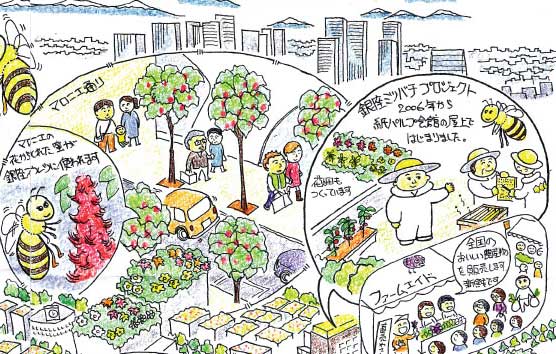Ranked with the Fifth Avenue shopping district in New York City, Japan's Ginza district in Tokyo is one of the world's leading downtown districts, complete with high-class department stores and designer shops. Today, bee honey collected from hives there is starting to attract people's attention. Ginza honeybees are nicknamed "Ginpachi" (short for "Ginza bees" in Japanese), and recently they have become somewhat of a new mascot for the district.
Birth of the Ginza Bee Project
The aim of the project is to interact with the local environment and ecosystems in Ginza through beekeeping. Although Ginza, which is located in the middle of Tokyo, has some small green areas, these groups are trying to learn more about how a sustainable society and the local environment operates by working with honeybees and using the honey they produce.

Is it really possible to keep honeybees and collect honey in an urban area such as Ginza? Many were suspicious. Honeybees are said to fly within a three- to four-kilometer radius from their hives to collect nectar. Fortunately, parks rich in green space are located within two kilometers, such as the Imperial Palace, Hibiya Park, and Hama-rikyu Gardens. Furthermore, many roadside trees are also good sources of nectar. The amount of honey collected has been increasing steadily,
The honeybee is said to be an environmental indicator species because it is extremely susceptible to pesticides, which are used on vast areas of farmland in Japan, and are causing the survival rate of bees to drop. Meanwhile, in Ginza, which is in the central part of metropolitan Tokyo, the use of pesticides is avoided because of the growing number of people with allergies. So Ginza has ended up being a bee-friendly environment, and the high-quality honey-producing Ginza bees have made people aware that the district has a rich natural environment.
Since the bees were brought to Ginza, cherry blossoms that had previously not been pollinated began to produce cherries. People began to see birds eating the cherries, and small insects began rejuvenating the environment around the area.
The extraordinary combination of Ginza and honeybees has attracted attention from the public and media since the start of the project, and more and more people are enjoying Ginza honey. People began thinking of not only the bees and the honey they produce in Ginza but also the natural environment around the whole region.
Read more of Ginza Green Project Focused on Growing Local, Eating Local by Yuriko Yoneda